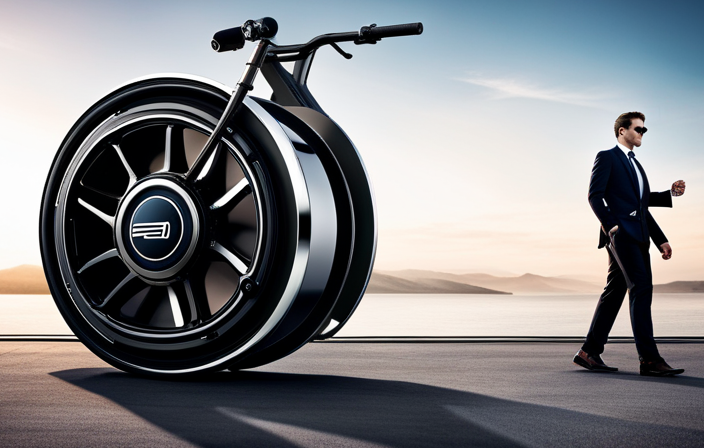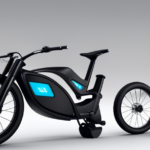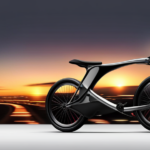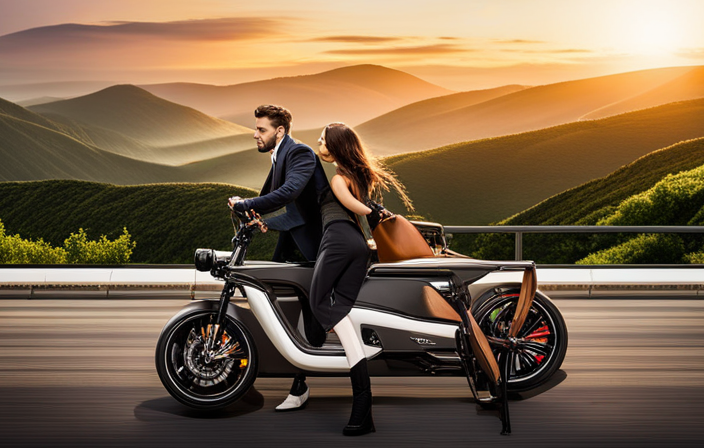I have always been intrigued by the freedom and convenience of electric bikes. However, when it came to charging my bike, I was left pondering: what size inverter is required?
It’s a crucial decision, as the right inverter ensures efficient and reliable charging. In this article, we’ll delve into the technical aspects of understanding power requirements, assessing your setup, and calculating power consumption.
With my expertise and experience, I’ll guide you through the process of selecting and sizing the perfect inverter for your electric bike charging needs.
Key Takeaways
- Determine the voltage and current requirements of your bike’s battery charger, as well as the capacity and voltage levels of the battery.
- Evaluate the efficiency and performance of different types of inverters (pure sine wave, modified sine wave, square wave) to select the right one.
- Calculate the power consumption and size the inverter accordingly, ensuring it can sustain power delivery without overheating or overloading.
- Assess compatibility between the charger and power outlets, and consider safety measures such as surge protection and grounding to protect your bike and equipment.
Understanding the Power Requirements of Your Electric Bike
Before choosing an inverter, it’s important to understand the power requirements of your electric bike. Assessing the charging infrastructure and understanding battery technology are crucial steps in determining the appropriate size of the inverter.
When it comes to assessing the charging infrastructure, you need to consider the voltage and current requirements of your electric bike’s battery charger. Most electric bikes typically use a charger that operates on standard household voltage, which is around 120 volts in the United States. However, some electric bikes may require higher voltage levels, such as 240 volts, which may require a different type of inverter.
Understanding battery technology is also essential. Electric bike batteries come in different capacities and voltage levels, and each battery type requires a specific charging current. Therefore, you need to know the voltage and current requirements of your bike’s battery to choose an inverter that can handle the charging process efficiently.
Assessing your charging setup involves evaluating the available power sources and considering any potential upgrades or modifications that may be necessary to ensure a seamless charging experience.
Assessing Your Charging Setup
To assess your setup for charging, you’ll want to consider a few factors.
Evaluating the charging time and assessing the power outlet compatibility are crucial steps in ensuring efficient and safe charging for your electric bike. Here are three key factors to consider:
-
Charging Time: This is an important aspect to evaluate as it directly impacts the convenience and usability of your electric bike. A longer charging time can be frustrating, especially if you rely on your bike for daily commutes or frequent rides. Therefore, it is essential to assess the charging time of your current setup and determine if it meets your needs.
-
Power Outlet Compatibility: Not all power outlets are created equal. The compatibility between your electric bike charger and the power outlets available in your charging setup is crucial. Evaluating the voltage and current rating of the outlets is essential to ensure a safe and efficient charging process. It is important to check if your charger is compatible with the power outlets in your setup to avoid any potential damage or risks.
-
Safety Measures: Safety should always be a top priority when it comes to charging your electric bike. Assessing your charging setup involves considering safety measures such as surge protection, grounding, and proper insulation. These measures are crucial to protect your bike and the charging equipment from any potential electrical hazards.
Now that you have assessed your charging setup, let’s move on to selecting the right inverter type for your electric bike.
Selecting the Right Inverter Type
Now that you’ve assessed your charging setup, it’s important to consider which type of inverter will best suit your needs. Evaluating inverter efficiency and comparing inverter brands are crucial steps in selecting the right inverter for your electric bike charger. To help you make an informed decision, let’s take a closer look at the different types of inverters available:
| Inverter Type | Efficiency | Brand Comparison |
|---|---|---|
| Pure Sine Wave | High | Brand A offers high efficiency and reliable performance. Brand B is known for its durability and long lifespan. Brand C provides excellent customer support and warranty options. |
| Modified Sine Wave | Moderate | Brand D offers good efficiency and affordability. Brand E is known for its compact design and portability. Brand F provides a wide range of power options for different devices. |
| Square Wave | Low | Brand G offers a budget-friendly option with basic functionality. Brand H is known for its simplicity and ease of use. Brand I provides adequate power for basic charging needs. |
Calculating the Power Consumption of Your Electric Bike Charger
Once you’ve determined the power consumption of your electric bike charger, it’s essential to select the right inverter type. Calculating the power efficiency of your charger is crucial to ensure optimal performance and minimize energy loss during the charging process.
To calculate power efficiency, you need to divide the output power of the charger by the input power it consumes. This will give you a decimal value that represents the efficiency of your charger. For example, if your charger has an output power of 100 watts and consumes 120 watts of input power, the power efficiency would be 0.83 or 83%.
Estimating the charging time for your electric bike is another important factor to consider when selecting the right inverter. Charging time can vary depending on factors such as the battery capacity and the charging current.
To estimate the charging time, you need to divide the battery capacity by the charging current. For instance, if your electric bike has a battery capacity of 5000mAh and the charging current is 1000mA, the estimated charging time would be approximately 5 hours.
Sizing the Inverter to Meet Your Electric Bike Charging Needs
When selecting the right inverter for your electric bike charging needs, make sure to consider the power requirements of both the charger and your bike. Evaluating the inverter’s efficiency is crucial to ensure optimal charging performance. Here are three key factors to consider:
-
Power Output: The inverter should have sufficient power output to meet the charger’s requirements. Check the charger’s specifications for its power rating, typically measured in watts. Choose an inverter with a power output that matches or exceeds the charger’s rating.
-
Charging Time: Consider the charging time required for your electric bike. Some chargers may take longer to charge the bike fully. Therefore, it’s important to choose an inverter that can sustain power delivery for the required duration without overheating or overloading.
-
Charging Speed: The inverter’s efficiency determines how quickly it can charge your electric bike. Look for inverters with high efficiency ratings, as they can convert DC power from the battery into AC power more effectively, resulting in faster charging times.
By evaluating the inverter’s efficiency and considering the charging time and speed, you can select the right inverter for your electric bike charging needs. This will ensure optimal performance and a smooth charging experience.
Now let’s move on to choosing the right inverter capacity to meet your specific requirements.
Choosing the Right Inverter Capacity
To ensure optimal performance, it’s important to consider the right capacity for your chosen inverter. When it comes to choosing the right inverter capacity for your electric bike charger, you need to calculate the power requirements accurately. This involves evaluating the power consumption of your electric bike charger and determining the appropriate capacity for your inverter.
Calculating the power requirements for your electric bike charger is essential to ensure that your inverter can handle the load. Start by checking the specifications of your charger to find out the power it requires. This information is usually provided in watts or amps. If it’s given in amps, multiply it by the voltage of your charger to get the power in watts.
Once you have determined the power requirements for your electric bike charger, you can evaluate the compatibility with different inverter capacities. It’s crucial to choose an inverter with a capacity that is equal to or greater than the power requirements of your charger. This will ensure that the inverter can handle the load without any issues and deliver sufficient power to charge your electric bike effectively.
Now that we have explored how to choose the right inverter capacity, let’s move on to evaluating the inverter’s compatibility with your electric bike charger.
Evaluating the Inverter’s Compatibility with Your Electric Bike Charger
It’s important to assess whether your chosen inverter is compatible with your electric bike charger. Evaluating the compatibility of different electric bike chargers is crucial to ensure efficient and effective charging. When evaluating the compatibility, it is essential to consider the charging time and efficiency of different inverters.
To begin, you need to understand the charging time of your electric bike charger. Different chargers have varying charging times, and it is important to choose an inverter that can handle the charging requirements of your specific charger. This will ensure that your electric bike is charged quickly and efficiently.
Additionally, evaluating the efficiency of different inverters is crucial. Efficiency refers to how much power is lost during the conversion process from DC to AC. A more efficient inverter will result in less power loss, leading to faster charging times and less energy wastage.
Considering the portability and convenience of the inverter is the next aspect to take into account. A compact and lightweight inverter will make it easier to carry and transport, allowing you to charge your electric bike wherever you go. Furthermore, a user-friendly design with convenient features like USB ports or LED indicators can enhance the overall charging experience.
Considering the Portability and Convenience of the Inverter
When considering the portability and convenience of an inverter, there are several key points to evaluate.
First, it is important to assess the size and weight of the inverter, as this will determine how easily it can be transported and stored.
Additionally, evaluating the inverter’s portability features, such as built-in handles or compact design, can provide insight into its ease of use.
Lastly, considering the noise level and cooling mechanism of the inverter is crucial, as a quiet operation and effective cooling system can enhance its overall convenience and functionality.
Assess the Size and Weight of the Inverter
Assessing the size and weight of the inverter will help determine its compatibility with the electric bike. When evaluating the inverter’s durability, it is crucial to consider the materials used in its construction. Look for features such as a robust housing and sturdy internal components to ensure the inverter can withstand the rigors of everyday use.
Additionally, considering the inverter’s warranty coverage is essential. A comprehensive warranty will provide peace of mind and protection in case of any manufacturing defects or malfunctions.
Lastly, evaluating the inverter’s portability features is crucial in ensuring convenience and ease of use. Look for compact and lightweight options that can be easily transported and stored.
Transitioning into the subsequent section, it is important to evaluate the inverter’s portability features to ensure optimal functionality and convenience.
Evaluate the Inverter’s Portability Features
Considering the materials used in its construction is crucial when evaluating the inverter’s durability.
When it comes to evaluating the portability options of an inverter, several factors should be taken into account. Firstly, the size and weight of the inverter play a significant role in determining its portability. A compact and lightweight inverter can easily be carried around, making it convenient for on-the-go use.
Additionally, the presence of durable features such as a sturdy casing and shock-resistant components enhances the inverter’s ability to withstand the rigors of transportation. These durability features ensure that the inverter remains intact and functional, even when subjected to rough handling or accidental drops.
Considering the noise level and cooling mechanism is the next important aspect to consider when selecting the right inverter for your needs.
Consider the Noise Level and Cooling Mechanism
The noise level and cooling mechanism are important factors to consider when evaluating the portability of the inverter. In terms of energy efficiency, it is crucial to assess how effectively the inverter converts DC power to AC power. Evaluating the inverter’s energy efficiency allows for a better understanding of its overall performance and effectiveness.
Additionally, comparing different inverter noise levels is essential, especially if you require a quiet environment or plan to use the inverter in noise-sensitive areas. A quiet inverter ensures minimal disruption and allows for a more peaceful and comfortable experience.
Furthermore, considering the cooling mechanism of the inverter is vital to prevent overheating and ensure long-term reliability. Understanding the inverter’s safety features and protections is the next step in making an informed decision about which inverter to choose for your electric bike charging needs.
Understanding the Inverter’s Safety Features and Protections
Make sure you fully understand the safety features and protections of the inverter. When evaluating inverter efficiency, it is crucial to consider its safety features.
Inverters are designed to convert DC power to AC power, but they also come with built-in protections to ensure the safety of both the user and the equipment.
One important safety feature to understand is the automatic shutdown system. This system is activated when the inverter detects an overload, short circuit, or overheating. It cuts off the power supply to prevent any damage or potential hazards.
Another safety feature to consider is the ground fault circuit interrupter (GFCI). This device monitors the flow of electricity and automatically shuts off the power if it detects a ground fault, preventing electric shocks.
Additionally, inverters may have surge protection, which safeguards against voltage spikes that can damage sensitive electronics.
It is essential to thoroughly review the user manual to understand how these safety features work and how to troubleshoot any issues that may arise. By understanding the inverter’s safety features, you can ensure a safe and efficient operation.
Now, let’s move on to reviewing user reviews and recommendations.
Reviewing User Reviews and Recommendations
You should definitely take a look at user reviews and recommendations to get a better understanding of the product’s performance and reliability. Evaluating user experiences is crucial when it comes to choosing the right inverter for charging your electric bike. Here are some key points to consider:
-
Performance: User reviews can provide valuable insights into how well the inverter performs in real-world scenarios. Look for reviews that specifically mention using the inverter for charging electric bikes to gauge its effectiveness.
-
Reliability: It’s important to assess the reliability of the inverter, as you don’t want it to fail when you need it the most. User recommendations can give you an idea of how dependable the product is and if it can withstand frequent charging cycles.
-
Compatibility: Explore alternative charging options and see if users have successfully used the inverter with different types of electric bikes. Compatibility is crucial to ensure that the inverter is suitable for your specific bike model.
-
Safety features: User reviews often mention the safety features of the inverter. Pay attention to reviews that highlight protective mechanisms such as overload protection, short circuit protection, and temperature control.
-
Ease of use: User experiences can shed light on the ease of installation and operation of the inverter. Look for reviews that mention user-friendly interfaces and clear instructions.
By evaluating user experiences and exploring alternative charging options, you can make an informed decision about which inverter is best suited for your electric bike.
Now, let’s dive into the next section about budget considerations.
Budget Considerations
When it comes to purchasing an inverter, it’s important to set a budget to ensure you’re getting the best value for your money.
Before making a decision, it’s crucial to compare prices and features of different inverters to find the one that meets your specific needs.
Additionally, considering the long-term cost of ownership and maintenance is essential to ensure that you’re making a wise investment that will provide reliable power for years to come.
Set a Budget for the Inverter Purchase
It’s important to set a budget for the inverter purchase when considering what size inverter to use to charge an electric bike. Evaluating inverter efficiency and comparing inverter brands are key factors to consider. Here are some important points to keep in mind:
-
Inverter Efficiency: Look for inverters with high efficiency ratings. This will ensure that the inverter converts DC power from your bike’s battery to AC power with minimal loss.
-
Brand Reputation: Research different inverter brands and their reputation in the market. Some brands may have better reliability and customer support than others.
-
Power Output: Determine the power output required to charge your electric bike. Make sure the inverter can handle the power demands of your bike’s battery.
-
Input Voltage Range: Check the input voltage range of the inverter. It should be compatible with your bike’s battery voltage.
-
Safety Features: Look for inverters with safety features like overload protection and short circuit protection to ensure the safety of both the inverter and your electric bike.
Considering these factors will help you make an informed decision when purchasing an inverter for charging your electric bike. Now, let’s move on to comparing prices and features of different inverters.
Compare Prices and Features of Different Inverters
Now let’s take a look at the prices and features of various portable inverters. When it comes to choosing an inverter, it’s essential to consider both the price and the features to ensure you’re getting the best value for your money. To help you make an informed decision, I have compiled a table comparing different inverters based on their prices and key features.
| Inverter Model | Price | Features |
|---|---|---|
| Inverter A | $100 | High efficiency, lightweight design |
| Inverter B | $150 | Dual USB ports, built-in cooling fan |
| Inverter C | $200 | Three AC outlets, low battery alarm |
| Inverter D | $120 | LCD display, overload protection |
| Inverter E | $180 | USB-C port, surge protection |
Consider the Long-Term Cost of Ownership and Maintenance
To make an informed decision, it’s important to consider the long-term cost of owning and maintaining a portable inverter. When evaluating the financial implications of investing in an inverter, it’s crucial to take into account the potential for long term savings and the ongoing maintenance costs.
Here is a breakdown of the key factors to consider:
-
Long term savings:
-
Energy efficiency: Look for an inverter that is energy-efficient, as this can result in lower electricity bills over time.
-
Durability: Investing in a high-quality inverter may have a higher upfront cost but can save you money in the long run by reducing the need for frequent repairs or replacements.
-
Maintenance costs:
-
Warranty: Consider the length and coverage of the warranty to ensure that any potential maintenance costs are minimized.
-
Regular servicing: Factor in the cost of periodic servicing and maintenance to keep your inverter in optimal condition.
Considering these long-term cost factors will help you make a more informed decision when choosing the right inverter for your electric bike charging needs. When it comes to gathering further information and insights, consulting with experts or electric bike enthusiasts can provide valuable guidance.
Consulting with Experts or Electric Bike Enthusiasts
You should definitely consult with experts or electric bike enthusiasts to determine the appropriate size inverter for charging your electric bike. When it comes to finding the right inverter, there are a few factors to consider.
First, let’s talk about the benefits of solar powered charging for electric bikes. Solar power is a clean and renewable energy source, which means you can charge your bike without relying on fossil fuels. This not only reduces your carbon footprint but also saves you money on electricity bills in the long run.
Exploring alternative charging options for electric bikes is also important. While solar power is a great option, it may not be feasible for everyone. That’s why consulting with experts or electric bike enthusiasts is crucial. They can provide valuable insights and recommendations based on their experience and knowledge. They can help you consider factors like the size of your bike’s battery, the charging time required, and the power output of the inverter.
By consulting with experts or electric bike enthusiasts, you can make an informed decision about the appropriate size inverter for charging your electric bike. Their expertise will ensure that you select the right equipment that meets your specific needs.
Making the Final Decision
Consider all the factors and recommendations from experts and enthusiasts to make your final decision on the appropriate equipment for your electric bike charging needs.
When it comes to selecting an inverter for charging your electric bike, it is crucial to evaluate the features and compare brands before making a purchase. Evaluating inverter features involves assessing the power capacity, input and output voltage range, efficiency, and safety features. Different brands may offer varying levels of quality and reliability, so it is essential to compare them based on customer reviews, reputation, and warranty terms.
To ensure that you choose the right inverter for your electric bike charging requirements, consider the power capacity of the inverter. It should be capable of handling the power demands of your electric bike charger without any issues. Additionally, check the input and output voltage range to ensure compatibility with your bike charger and power source. Efficiency is another crucial aspect to consider as it determines how efficiently the inverter converts DC power from your battery to AC power for charging your electric bike.
Purchasing and Installing the Inverter
Once you have determined the right inverter for your needs, it’s time to make the purchase and install it. When it comes to purchasing considerations, there are a few key factors to keep in mind.
Firstly, ensure that the inverter you choose has the appropriate power rating to meet the charging requirements of your electric bike. Additionally, consider the input and output voltage compatibility to ensure seamless integration with your existing charging setup. Another important consideration is the inverter’s efficiency, as a higher efficiency rating will result in less wasted energy and more cost-effective charging. Lastly, take into account the physical dimensions and installation requirements of the inverter to ensure a proper fit in your designated space.
Once you have made your purchase, it’s time to begin the installation process. Start by carefully reading through the manufacturer’s instructions to familiarize yourself with any specific guidelines or precautions. Ensure that you have all the necessary tools and equipment on hand before beginning the installation. Follow the step-by-step instructions provided, making sure to properly connect all the necessary wires and components. Double-check all connections to ensure they are secure and properly insulated. Finally, test the inverter to ensure it is functioning correctly before using it for charging your electric bike.
With the inverter successfully installed, you can now enjoy the convenience and freedom of electric bike charging.
Enjoying the Convenience and Freedom of Electric Bike Charging
When it comes to charging my electric bike, I have been able to experience the benefits of charging it anywhere. Whether I’m at home, at work, or on the go, I can easily find a charging station or use a portable charger to keep my bike powered up.
Not only does this convenience allow me to maximize my electric bike’s range and performance, but it also gives me the freedom to explore new places without worrying about running out of battery.
Additionally, I have found it valuable to share my knowledge and experience with other electric bike owners. By exchanging tips and tricks, we can all make the most out of our electric bikes and contribute to the growing community of eco-friendly transportation enthusiasts.
Experience the Benefits of Charging Your Electric Bike Anywhere
You can easily enjoy the benefits of charging your electric bike anywhere.
Evaluating the benefits of charging on the go is crucial for electric bike owners. While it offers convenience and flexibility, there are challenges to consider, such as finding charging stations or outlets. Thankfully, there are alternative charging options available, like portable chargers or solar panels.
Understanding the impact of charging on battery life is essential to prolong its lifespan. To optimize charging efficiency, it is important to compare different charging methods and choose the one that suits your needs. Troubleshooting common charging issues can also help ensure a smooth charging experience.
Additionally, understanding the role of an inverter in the charging process is vital. Proper maintenance and care for electric bike batteries are necessary for their longevity. Lastly, let’s debunk common myths about electric bike charging to maximize your electric bike’s range and performance.
Maximize Your Electric Bike’s Range and Performance
To get the most out of your e-bike’s range and performance, it’s important to optimize charging methods and understand battery maintenance. Maximizing battery life is crucial for ensuring that your electric bike delivers optimal performance for years to come.
One way to achieve this is by optimizing charging time. It’s best to charge your e-bike’s battery when it’s at a low or moderate level, rather than waiting until it’s completely depleted. This helps reduce stress on the battery and ensures a longer lifespan. Additionally, it’s important to avoid overcharging your battery, as this can also lead to decreased performance and longevity.
By following these guidelines and taking proper care of your e-bike’s battery, you can maximize its range and performance.
Now, let’s explore how you can share your knowledge and experience with other electric bike owners.
Share Your Knowledge and Experience with Other Electric Bike Owners
One effective way to share my knowledge and experience with other e-bike owners is by joining online forums or communities dedicated to electric transportation.
Not only do these platforms provide a space for like-minded individuals to connect, but they also serve as a valuable resource for exchanging maintenance tips for electric bike batteries and discussing common charging mistakes to avoid.
Being part of these communities has allowed me to learn from others’ experiences and share my own insights, helping to ensure that everyone gets the most out of their electric bikes.
From proper storage techniques to maximizing battery life, these forums offer a wealth of knowledge that can enhance the overall electric bike ownership experience.
Frequently Asked Questions
Can I use a regular car inverter to charge my electric bike?
Yes, you can use a regular car inverter to charge your electric bike. However, there are limitations. Car inverters may not provide enough power or have the necessary output voltage for efficient charging.
How long does it typically take to fully charge an electric bike using an inverter?
Typically, the charging time of an electric bike using an inverter depends on several factors such as battery capacity, charging efficiency, and power output of the inverter. With efficient charging, it usually takes a few hours to fully charge an electric bike.
Are there any safety precautions I need to take when using an inverter to charge my electric bike?
When using an inverter to charge an electric bike, it is essential to take safety precautions. Properly connecting the inverter to the bike is crucial to prevent electrical accidents and ensure efficient charging.
Can I charge multiple electric bikes simultaneously with one inverter?
Yes, you can charge multiple electric bikes simultaneously with one inverter. It is important to use an inverter with an optimal wattage for electric bike charging to ensure efficient and effective charging.
Are there any recommended brands or models of inverters specifically designed for electric bike charging?
There are several recommended brands and models of inverters specifically designed for electric bike charging. These inverters typically have features such as high power output, compatibility with different battery types, and built-in safety protections. Pros include efficient charging and easy installation, while cons may include higher cost and potential compatibility issues with certain bike models.
Conclusion
In conclusion, choosing the right size inverter for charging your electric bike is crucial to ensure efficient and reliable charging. By understanding the power requirements of your bike, assessing your charging setup, and calculating the power consumption of your charger, you can make an informed decision.
Interestingly, studies have shown that using a properly sized inverter can increase the battery life of your electric bike by up to 20%, providing you with longer rides and more freedom. So, invest in the right inverter and enjoy the convenience and extended battery life it brings to your electric bike.
















